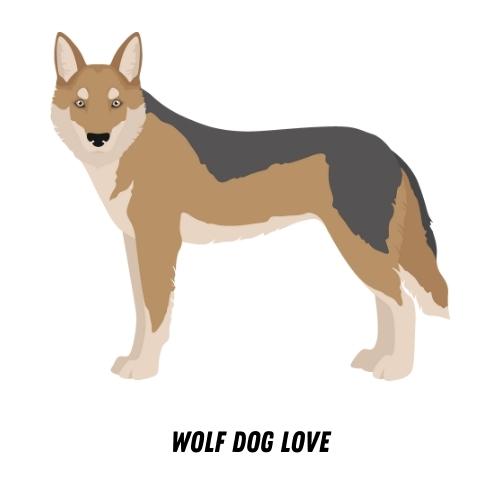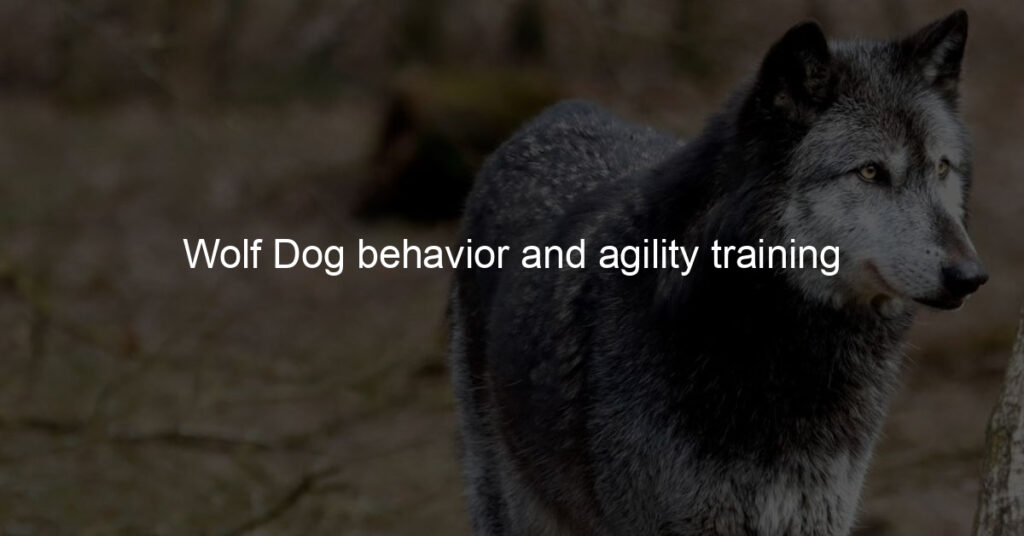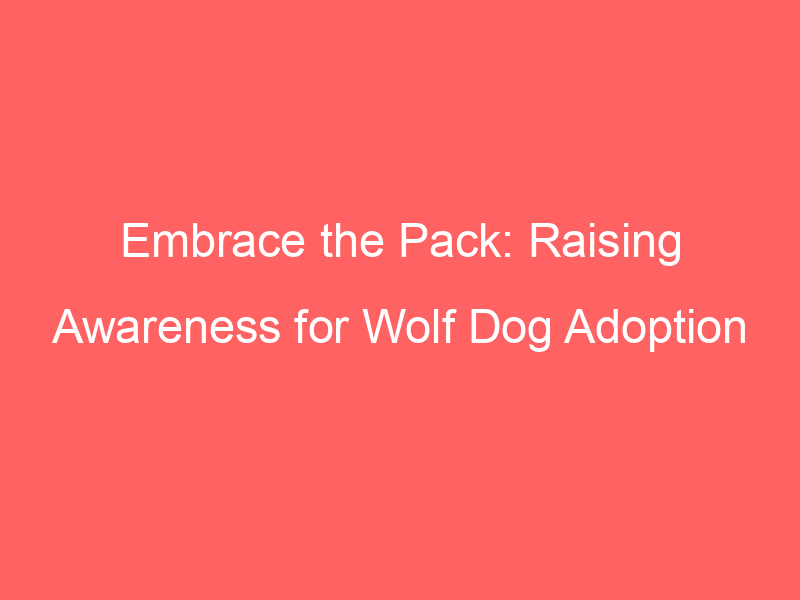If you’re a pet owner of a wolfdog, you already know they’re far from ordinary. Wolfdogs are beautiful and majestic animals who possess both physical and mental traits that surpass those of the average pup – making them both incredibly rewarding to own yet challenging to train. With their wild nature comes complex abilities to learn, adapt, and exercise in ways that must be kept in check by an experienced canine trainer or behaviorist.
How can I train my Wolf Dog for agility?
Training a Wolf Dog for agility requires patience, consistency, and dedication. While many people may believe that it is difficult to train a Wolf Dog, the truth is that they are very well suited to agility training.
After establishing a consistent training routine, start by introducing some basic commands such as sit and stay. As you progress with agility training drills, different obstacles can be gradually added such as hurdles, tunnels, and weave poles.
Be sure to reward your pet with treats or praise each time they successfully complete an obstacle. With adequate practice, your Wolf Dog will quickly become an expert at running the course!
What are some agility training exercises for Wolf Dogs?
Agility training is a great way to help keep your Wolf Dog active and engaged. It helps them develop their cognitive and physical skills as well as builds up trust between you and your pup.
So, what exactly are some agility exercises for Wolf Dogs? It can be as simple as running with your pup, and having them perform basic commands such as come, sit, stay, and lay down on command.
More elaborate exercises include weaving through poles, navigating through tunnels and ladders, or teaching the pup how to jump over different objects at variable heights.
All of these exercises can help to build muscle strength in your pup while helping to stimulate mental alertness within them as they figure out how to complete the tasks correctly. With regular agility sessions with your Wolf Dog, they’ll soon be ready to compete against other wolf dogs at agility competitions!
What is the best age to start agility training for Wolf Dogs?
Wolf Dogs are an impressive breed due to their intelligence and athleticism, making them great candidates for agility training. Unfortunately, they can easily become bored so the right age is important to get the best results.
8-12 months is considered the ideal time to start as they are still young enough that all commands and techniques taught at this age will be absorbed more quickly. Training will also give them plenty to keep their minds occupied which can help ward off a large portion of behavioral issues often experienced by Wolf Dogs.
During these early stages, it’s helpful to keep sessions interesting and fun with plenty of rewards and verbal praise. That way your Wolf Dog stays motivated without feeling overwhelmed or discouraged by any failed tasks.
Can Wolf Dogs excel in agility competitions?
Wolf Dogs have the potential to be excellent agility competitors, given their hardworking and intelligent natures. With proper training, exercise, and socialization, these hybrid dogs can learn complicated courses with ease.
It has even been noted that Wolf Dog hybrids tend to excel in obstacle-based competitions because they enjoy finding inventive new ways to get through tasks quickly and efficiently.
Even though they may need more frequent breaks than other canine competitors due to their strong endurance capabilities, dedicated handlers will no doubt find success in agility competitions with their Wolf Dogs partners.
What are the benefits of agility training for Wolf Dogs?
Agility training for Wolf Dogs has numerous benefits and is a great way to bond with your pup. Not only can agility courses help strengthen the dog’s overall physical and mental health, but they also provide mental stimulation with the challenge of navigating obstacles and using problem-solving skills, creating a rewarding experience for both dog and the handler.
Agility is a great form of exercise that will keep your Wolf Dog active as they run, and jump over and through various obstacles, enabling the development of fast reflexes. And while they’re running around having fun, you’ll have time to build a strong relationship with your pup as you motivate them to complete the course. The self-discipline agility requires helps owners gain their Wolf Dog’s respect and trust, forming an everlasting bond between them.
Are there any risks associated with agility training for Wolf Dogs?
Agility training can be beneficial for Wolf Dogs, providing them with the physical and mental stimulation they need. However, it is important to note that agility training is not without its risks – injury and anxious behaviors can arise if the activity is done incorrectly.
Poor handling or even too much speed can result in issues with musculoskeletal strain and this could have a long-term effect on your pet’s well-being. Additionally, improper techniques while teaching may also cause aversive responses and can end up hurting their behavior.
It is important to ensure that any agility training you do with your Wolf Dog is supervised by an expert professional who knows how to use rewards-based methods for teaching, as this will minimize the potential for any of these risks.
How long does it take to train a Wolf Dog for agility?
When it comes to training a Wolf Dog for agility, the process can vary widely depending on the breed and individual temperament. While some wolf crosses can be trained using traditional methods within a few months, others may require much more time and effort.
Generally speaking, most dogs will need between 6 and 12 months of consistent training to learn everything from basic commands to tricky tricks for the agility course.
The key is to make sure that each new task is taken at their own pace so that they remain motivated and build up confident skills over time. With patience, commitment, and lots of treats, you can train your Wolf Dog for agility in no time!
What is Wolf dog behavior?
Wolf dogs, a hybrid of gray wolves and domestic dogs, are an interesting species to observe. With the intelligence of wolves and the loyalty of canines, their behavior is unique. Wolf dogs usually exhibit a balanced blend of both wolf and dog characteristics, making their temperaments relatively unpredictable – it all depends on their genetic mix!
Typically, you might spot a wolf-dog bark like a normal mutt, but more so to warn other canines in their area or work as sentinels for their family pack. They don’t need much exercise thanks to their wild heritage, which means they tend to get bored easily if given nothing to do.
If you’re considering bringing home one of these majestic creatures, be sure to read up on them first – for example, chances are you’ll need plenty of patience and understanding when it comes to proper training!
Can I train my Wolf Dog for agility at home?
Wolf Dogs are a unique and amazing breed – a combination of wolf-like characteristics and domesticated behavior. People who keep these majestic animals often want to train their dogs for agility, but worry whether it is possible to do so at home.
The answer is yes! With patience and consistency, you can train your Wolf Dog for agility exercises in your backyard or at a park close by. Your pup should start with the basics – balance exercises such as walking on obstacles or climbing stairs.
Then include more complicated activities like jumping hurdles or shooting hoops. With the right training, you will have an agile and obedient companion by your side in no time!
Are there any specific diets for Wolf Dogs in agility training?
One of the most important things to consider when training a Wolf Dog for agility is its diet. Wolf Dogs need specific diets that differ from the traditional diets recommended for pet dogs, as they have a higher metabolic rate and can’t easily digest a lot of common canine foods.
A common issue with Wolf Dogs taking part in agility training is a lack of energy and stamina due to nutritional deficiencies or the wrong choice of food. It’s important to understand exactly what your dog needs to be healthy and perform at their best while participating in this activity, so make sure to consult with an animal nutrition specialist about creating the perfect dietary plan before beginning agility training with your Wolf Dog.
What are some common mistakes to avoid during Wolf Dog agility training?
Wolf Dog agility training is an incredibly rewarding activity for both owner and pup. It helps the dog maintain a healthy mental and physical balance while building trustful relationships with their owners.
With that said, there are certain mistakes that many trainers and new owners tend to make during this type of exercise. One of the most important lessons to learn is to keep your commands simple and specific, allowing your wolf-dog to focus on mastering them as quickly as possible.
Additionally, it’s vital to address any potty breaks outside of the training session itself; if you have to pause mid-session it won’t help reinforce any behavior you wish for your pup to learn.
Lastly, remember to take things slow – each step should be broken down into mini-activities so that they can eventually be combined into finished behaviors. That way even complex exercises will be much easier for your wolf dog to pick up and complete without confusion or fear.
Conclusion
All in all, wolf dogs are a unique and often misunderstood breed of animals. From their intelligence and agility to their carefully monitored behavior patterns, this special crossbreed requires more attention than your average dog. With the right kind of training and socialization, wolf dogs can be friendly and devoted companions that know how to use their strengths for a variety of tasks. While these hybrids are certainly not for everyone, those with experience and dedication can work towards building an amazing relationship.








